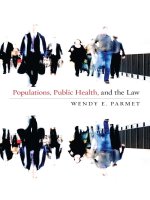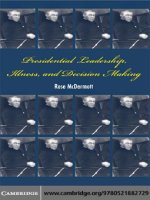0521689317 cambridge university press atiyahs accidents compensation and the law oct 2006
Bạn đang xem bản rút gọn của tài liệu. Xem và tải ngay bản đầy đủ của tài liệu tại đây (2.58 MB, 551 trang )
This page intentionally left blank
Atiyah’s Accidents, Compensation and the Law Seventh Edition
Since its first publication, Accidents, Compensation and the Law has been
recognised as the leading treatment of the law of personal injuries compensation
and the social, political and economic issues surrounding it. The seventh edition
of this classic work explores recent momentous changes in personal injury law
and practice and puts them into broad perspective. Most significantly, it
examines developments affecting the financing and conduct of personal injury
claiming: the abolition of legal aid for most personal injury claims; the increasing
use of conditional fee agreements and after-the-event insurance; the meteoric
rise and impending regulation of the claims management industry. Complaints
that Britain is a ‘compensation culture’ suffering an ‘insurance crisis’ are
investigated. New statistics on tort claims are discussed, providing fresh insights
into the evolution of the tort system which, despite recent reforms, remains
deeply flawed and ripe for radical reform.
Peter Cane has been Professor of Law in the Research School of Social
Sciences at the Australian National University since 1997. For twenty years
previously he taught law at Corpus Christi College Oxford. His main research
interests are in the law of obligations, especially tort law; public law, especially
administrative law; and legal theory. Recent publications include Responsibility
in Law and Morality (2002) and The Oxford Handbook of Legal Studies (edited
with Mark Tushnet) (2003).
Patrick Atiyah is one of the leading common lawyers of his generation. Until
his early retirement in 1988 he was Professor of English Law at Oxford
University. His published writings range widely over topics in tort law, contract
law, legal history and legal theory; and include The Sale of Goods (11th edition
with J N Harpers and H L McQueen, 2005), The Rise and Fall of Freedom of
Contract (1985) and The Damages Lottery (1997).
The Law in Context Series
Editors: William Twining (University College London) and
Christopher McCrudden (Lincoln College, Oxford)
Since 1970 the Law in Context series has been in the forefront of the movement to broaden
the study of law. It has been a vehicle for the publication of innovative scholarly books that
treat law and legal phenomena critically in their social, political and economic contexts
from a variety of perspectives. The series particularly aims to publish scholarly legal
writing that brings fresh perspectives to bear on new and existing areas of law taught in
universities. A contextual approach involves treating legal subjects broadly, using materials from other social sciences, and from any other discipline that helps to explain the operation in practice of the subject under discussion. It is hoped that this orientation is at once
more stimulating and more realistic than the bare exposition of legal rules. The series
includes original books that have a different emphasis from traditional legal textbooks,
while maintaining the same high standards of scholarship. They are written primarily for
undergraduate and graduate students of law and of other disciplines, but most also appeal
to a wider readership. In the past, most books in the series have focused on English law,
but recent publications include books on European law, globalisation, transnational legal
processes, and comparative law.
Books in the Series
Anderson, Schum & Twining: Analysis of Evidence
Ashworth: Sentencing and Criminal Justice
Barton & Douglas: Law and Parenthood
Beecher-Monas: Evaluating Scientific Evidence: An Interdisciplinary Framework for
Intellectual Due Process
Bell: French Legal Cultures
Bercusson: European Labour Law
Birkinshaw: European Public Law
Birkinshaw: Freedom of Information: The Law, the Practice and the Ideal
Cane: Atiyah’s Accidents, Compensation and the Law
Clarke & Kohler: Property Law: Commentary and Materials
Collins: The Law of Contract
Davies: Perspectives on Labour Law
Dembour: Who Believes in Human Rights?: The European Convention in Question
de Sousa Santos: Toward a New Legal Common Sense
Diduck: Law’s Families
Elworthy & Holder: Environmental Protection: Text and Materials
Fortin: Children’s Rights and the Developing Law
Glover-Thomas: Reconstructing Mental Health Law and Policy
Gobert & Punch: Rethinking Corporate Crime
Harlow & Rawlings: Law and Administration
Harris: An Introduction to Law
Harris, Campbell & Halson Remedies in Contract and Tort
Harvey: Seeking Asylum in the UK: Problems and Prospects
Hervey & McHale: Health Law and the European Union
Lacey & Wells: Reconstructing Criminal Law
Lewis: Choice and the Legal Order: Rising above Politics
Likosky: Transnational Legal Processes
Maughan & Webb: Lawyering Skills and the Legal Process
McGlynn: Families and the European Union: Law, Politics and Pluralism
Moffat: Trusts Law: Text and Materials
Norrie: Crime, Reason and History
O’Dair: Legal Ethics
Oliver: Common Values and the Public-Private Divide
Oliver & Drewry: The Law and Parliament
Picciotto: International Business Taxation
Reed: Internet Law: Text and Materials
Richardson: Law, Process and Custody
Roberts & Palmer: Dispute Processes: ADR and the Primary Forms of Decision-Making
Scott & Black: Cranston’s Consumers and the Law
Seneviratne: Ombudsmen: Public Services and Administrative Justice
Stapleton: Product Liability
Tamanaha: The Struggle for Law as a Means to an End
Turpin: British Government and the Constitution: Text, Cases and Materials
Twining: Globalisation and Legal Theory
Twining: Rethinking Evidence
Twining & Miers: How to Do Things with Rules
Ward: A Critical Introduction to European Law
Ward: Shakespeare and Legal Imagination
Zander: Cases and Materials on the English Legal System
Zander: The Law-Making Process
Atiyah’s Accidents,
Compensation and the
Law
Seventh Edition
Peter Cane
Research School of Social Sciences
Australian National University
CAMBRIDGE UNIVERSITY PRESS
Cambridge, New York, Melbourne, Madrid, Cape Town, Singapore, São Paulo
Cambridge University Press
The Edinburgh Building, Cambridge CB2 8RU, UK
Published in the United States of America by Cambridge University Press, New York
www.cambridge.org
Information on this title: www.cambridge.org/9780521689311
© Cambridge University Press 2006
This publication is in copyright. Subject to statutory exception and to the provision of
relevant collective licensing agreements, no reproduction of any part may take place
without the written permission of Cambridge University Press.
First published in print format 2006
eBook (EBL)
ISBN-13 978-0-511-34855-6
ISBN-10 0-511-34855-X
eBook (EBL)
ISBN-13
ISBN-10
paperback
978-0-521-68931-1
paperback
0-521-68931-7
Cambridge University Press has no responsibility for the persistence or accuracy of urls
for external or third-party internet websites referred to in this publication, and does not
guarantee that any content on such websites is, or will remain, accurate or appropriate.
Contents
Preface
List of abbreviations
List of tables
Table of legislation
Table of cases
xiv
xvii
xxii
xxiii
xxviii
Part One: The Issues in Perspective
1
Introduction: surveying the field
1.1 Compensation for accidents
1.2 Natural and human causes
1.2.1 The issue
1.2.2 Society’s ‘responsibility’ for human causes
1.2.3 Protecting reasonable expectations
1.2.4 Egalitarianism and the problem of drawing the line
1.3 Mixed systems in a mixed society
1.4 Some facts and figures
1.4.1 Accidents causing personal injury or death
1.4.2 Death and disability from other causes
1.4.3 The prevalence of disability
1.4.4 The effect of disability on income
1.4.5 Distribution and sources of compensation
1.4.6 The more serious and the less serious
3
3
6
6
8
9
10
11
18
18
20
21
21
22
25
Part Two: The Tort System in Theory
2
Fault as a basis of liability
2.1
2.2
2.3
2.4
The conceptual basis of tort law
Negligence as a basis of liability
The fault principle
Negligence as fault
2.4.1 A question of fact?
2.4.2 The nature of negligence
33
33
34
35
36
36
40
vii
viii
Contents
2.4.3 Probability of harm
2.4.4 Likely magnitude of harm
2.4.5 The value of the activity and the cost of the
precautions needed to avoid harm
2.4.6 The function of the negligence formula
2.4.7 Foreseeability
2.4.8 The objective standard of care
2.4.9 Negligence in design and negligence in operation
2.5 Conduct of the claimant
2.5.1 Contributory negligence
2.5.2 Volenti non fit injuria
2.5.3 Illegality
3
The scope of the tort of negligence
3.1 The nature of the duty of care
3.2 Specific duty situations
3.2.1 Common situations in which duties of care
have been imposed
3.2.2 The distinction between acts and omissions
3.3 Nervous shock
3.4 Family claims
4
Departures from the fault principle
4.1
4.2
4.3
4.4
4.5
4.6
4.7
4.8
4.9
Fault liability and strict liability
‘Procedural’ devices
Breach of statutory duty
Contractual duties
Rylands v. Fletcher, nuisance and animals
Joint liability
Vicarious liability
Products liability
Proposals to extend strict liability
4.9.1 Dangerous things and activities
4.9.2 Railway accidents
4.10 Ex gratia compensation schemes
4.10.1 Vaccine damage
4.10.2 HIV
4.10.3 Hepatits C
4.10.4 Variant CJD
5
Causation and remoteness of damage
5.1 Introduction
5.2 Factual causation
42
43
45
46
47
48
50
53
54
61
65
68
68
70
70
72
84
89
92
92
94
95
99
100
101
102
103
105
105
106
107
107
108
108
109
110
110
111
Contents
5.2.1 Proving causation
5.2.2 Causing and increasing the risk of harm
5.2.3 Omissions
5.2.4 Multiple causal factors
5.3 Limits on the liability of factual causes
5.3.1 Legal causation
5.3.2 Damage not within the risk
5.3.3 Foreseeability again
5.4 Conclusion
6
Damages for personal injury and death
6.1 The lump sum: predicting the future
6.1.1 Personal injury cases
6.1.2 Fatal cases
6.1.3 Variation of awards after trial
6.1.4 Suitability of lump sums
6.1.5 Alternatives to lump sums
6.2 Full compensation
6.2.1 Interest
6.2.2 Lost earnings and support
6.2.3 Medical and other expenses
6.3 Full compensation for lost ‘earnings’: is it justified?
6.3.1 The earnings-related principle
6.3.2 The hundred-per cent principle
6.4 Full compensation: the commitment in practice
6.5 Intangible losses
6.5.1 Assessing intangible losses
6.5.2 The tariff system
6.5.3 Subjective factors
6.5.4 Should damages be payable for intangible losses?
6.6 Overall maxima
6.7 Punitive damages
7
An appraisal of the fault principle
7.1 The compensation payable bears no relation to
the degree of fault
7.2 The compensation bears no relation to the means of
the tortfeasor
7.3 A harm-doer may be legally liable without being
morally culpable and vice versa
7.3.1 Collective liability
7.3.2 The objective definition of fault
7.3.3 Moral culpability without legal liability
111
112
115
116
118
118
125
127
129
130
130
130
132
135
137
139
143
145
146
149
152
152
156
157
161
161
166
170
171
173
173
175
175
177
179
179
180
182
ix
x
Contents
7.4
7.5
7.6
7.7
7.3.4 The fault principle and popular morality
The fault principle pays little attention to the conduct
or needs of the victim
Justice may require payment of compensation without fault
It is often difficult to adjudicate allegations of fault
The fault principle contributes to a culture of blaming and
discourages people from taking responsibility for
their own lives
183
183
185
187
192
Part Three: The Tort System in Operation
8
Claims and claimants
8.1 Accident victims and tort claimants
8.1.1 Cases reaching trial
8.1.2 Cases set down for trial
8.1.3 Actions commenced
8.1.4 All tort claims
8.2 Why do people (not) make tort claims?
8.2.1 Some research findings
8.2.2 Alternative remedies
8.2.3 Claims consciousness
8.3 Particular types of claims
8.3.1 Road accidents
8.3.2 Industrial injuries and illnesses
8.3.3 Public liability claims
8.3.4 Medical injuries
8.3.5 Group claims
9
Tortfeasors and insurers
9.1
9.2
9.3
9.4
9.5
9.6
9.7
9.8
Defendants
Individuals as tort defendants
Employers and corporations as tort defendants
Insurers
The nature of liability insurance
Some problems of liability insurance
First-party insurance for the benefit of others
The impact of liability insurance on the law
9.8.1 Statutory provisions
9.8.2 The impact of insurance on the common law
9.9 The Motor Insurers’ Bureau
10
201
201
201
203
203
204
206
206
207
209
214
214
216
218
219
221
222
222
222
228
233
234
239
244
245
245
248
255
Trials and settlements
260
10.1 The importance of settlements
10.2 Obtaining legal assistance and financing tort claims
260
261
Contents
11
12
13
10.3 The course of negotiations
10.3.1 Individual claims
10.3.2 Group claims
10.4 When negotiations break down
10.5 The time taken to achieve a settlement
10.6 The amount of compensation
268
269
274
278
281
284
Part Four: Other Compensation Systems
First-party insurance
291
11.1 Types of first-party insurance
11.2 First-party insurance compared with tort liability
291
295
Compensation for criminal injuries
300
12.1
12.2
12.3
12.4
300
301
303
304
304
309
316
324
326
Tort claims
Compensation orders
Other sources of compensation
Criminal injuries compensation scheme
12.4.1 Justifications for the Scheme
12.4.2 The scope of the scheme
12.4.3 Comparison between the CICS and tort liability
12.4.4 Administration
12.4.5 Claims consciousness
The social security system
328
13.1 Foundations of the social security system
13.1.1 Workers’ compensation
13.1.2 National insurance
13.2 The Beveridge Report and the 1946 Acts
13.3 Developments since 1946
13.4 The industrial injuries system
13.4.1 The scope of the system
13.4.2 Accidents and diseases
13.4.3 Benefits
13.4.4 Administration
13.4.5 The tort system and the IIS compared
13.5 Non-work-related disablement
13.6 Preferences within State provision for the disabled
13.7 Income-support benefits
13.7.1 Benefits
13.7.2 Administration
13.8 Fraud and abuse
328
328
330
331
333
338
338
340
342
351
355
355
356
358
358
360
360
xi
xii
Contents
14
15
16
17
Other forms of assistance
363
14.1 The taxation system
14.2 Social services
14.2.1 Employment
14.2.2 Mobility
14.2.3 Housing and residential accommodation
14.2.4 Other social services
14.3 Conclusion
363
365
366
369
370
371
372
Part Five: The Overall Picture
A plethora of systems
377
15.1
15.2
15.3
15.4
The concept of over-compensation
The choice of compensation system
Subrogation and recoupment
Tort damages and other compensation
15.4.1 General principles
15.4.2 Tort damages and sick pay
15.4.3 Tort damages and personal insurance
15.4.4 Tort damages and charitable payments
15.4.5 Tort damages and social security benefits
15.5 Criminal injuries compensation
377
378
380
385
385
387
388
389
390
394
The cost of compensation and who pays it
395
16.1 The cost of tort compensation
16.2 Costs not paid through the tort system
16.2.1 The cost of social services
16.2.2 The cost of the social security system
16.2.3 Other sources of compensation
16.2.4 Costs in perspective
16.3 The cost of criminal injuries compensation
395
402
402
403
405
405
406
The functions of compensation systems
408
17.1 Compensation
17.1.1 Some preliminary questions
17.1.2 The meaning of ‘compensation’
17.1.3 Compensation and compensation systems
17.2 Distribution of losses
17.2.1 What should be distributed?
17.2.2 How should it be distributed?
17.3 The allocation of risks
17.4 Punishment
17.5 Corrective justice
408
408
411
414
415
415
416
418
419
421
Contents
17.6 Vindication or satisfaction
17.7 Deterrence and prevention
17.7.1 Rules and standards of behaviour
17.7.2 Accident prevention via insurance
17.8 General deterrence
17.8.1 The basic idea
17.8.2 Ascertaining the costs of an accident
17.8.3 Allocation of costs to activities
17.8.4 Responsiveness of price mechanism
17.8.5 Applying general deterrence criteria in practice
17.8.6 General deterrence and existing systems
17.8.7 An assessment of the value of the
general-deterrence approach
17.8.8 Conclusions about general deterrence
18
422
424
425
433
439
439
442
442
446
448
448
453
457
Part Six: The Future
Accident compensation in the twenty-first century
461
18.1 Where we are now and how we got here
18.2 Basic issues
18.2.1 Strict liability or no-fault?
18.2.2 Limited or comprehensive reform?
18.2.3 Preferential treatment
18.2.4 Assessment of compensation
18.2.5 Funding
18.2.6 Goals of the system
18.3 Proposals and schemes
18.3.1 Road accident schemes
18.3.2 Other schemes
18.4 The way ahead
18.4.1 A social welfare solution
18.4.2 A private insurance solution
18.5 Damage to property
18.6 The role of the insurance industry and the legal profession
461
467
467
468
472
474
477
478
484
484
487
488
488
493
495
496
Index
499
xiii
Preface
The seven years since I wrote the preface to the sixth edition have been ones of rapid
and momentous change in the tort system, affecting most particularly the financing
and settlement of personal injury claims. Some of these changes were foreshadowed
in the previous edition; but it was hard to predict the precise contours of the revolution that was about to be triggered by the abolition of legal aid for most personal
injury claims and the consequent growth of the claims management industry. Phrases
such as ‘compensation culture’, ‘blame culture’ and ‘insurance crisis’ have become
part of the common currency of public debate and political rhetoric in Britain. At the
same time, social security provision for the disabled and compensation for victims of
crime have continued to engage the concern and attention of the government and the
public, both being under review as I write. Nor is it only in Britain that personal
injury compensation looms large in legal and political debate. In the USA, for
instance, asbestos and medical malpractice litigation are matters of intractable and
acrimonious disagreement. In Australia, as a result of turmoil in the liability insurance industry, ‘tort reform’ became, for several months in 2002, the hottest issue in
domestic politics, leading to the appointment of a committee to review personal
injury law and, in its wake, major legislation in all jurisdictions. Despite widespread
dissatisfaction with the tort system, the past decade has (ironically, perhaps) seen its
further entrenchment in the political economy of personal injury compensation.
Except at the margins, the thrust of public policy has been to make the tort system
work better (whatever that might mean), not to replace it with something better.
Changes to the law, both in the areas already mentioned and in others such as the
assessment of damages, have required substantial rewriting of various parts of the
book. The opportunity of a new edition has also been taken to relocate the discussion of human and natural causes (which appeared in chapter 16 of the sixth
edition) into chapter 1 where (I think) it sits more comfortably. In this edition, too,
there is new discussion (particularly in chapter 4) of various forms of administrative compensation arrangements benefiting victims of hepatitis-C, black lung,
vibration white finger and other chronic externalities of modern industrial and
technological activities.
Moving away from law and procedure, undoubtedly the most important development since the last edition has been the increasing availability of reliable statistics
xiv
Preface
about the tort system. The NHS Litigation Authority now publishes detailed information about the number and cost of medical negligence (and other personal
injury) claims against NHS Trusts, and the Compensation Recovery Unit within
the Department of Work and Pensions – as administrator of schemes for recouping the cost of social security benefits and NHS treatment from payers of tort compensation – produces robust estimates of the total number of tort settlements. The
general picture that emerges is that tort claims have increased about threefold since
the 1970s (assuming that figures produced by the Pearson Commission were
reasonably accurate). The impact of this new information is most obvious in
chapter 8; but its influence pervades many parts of the book. As yet, intelligence
about the cost of compensation is more patchy and less reliable. In some areas –
criminal injuries compensation, for instance – the facts are known. But the total
cost of the tort system, for example, is a matter of considerable speculation and disagreement. Estimates of the total economic cost of personal injuries are even more
problematic. There seems little doubt, however, that the turnover of the compensation ‘industry’ (broadly understood) runs into the tens of billions of pounds per
annum – a significant amount by any standard.
As ever, the main aim of this book is to provide the reader with resources for
standing back from tort law and the tort system and viewing them in a larger legal
and social landscape. Whether placing tort at the centre of the picture in this way
continues to be desirable is a difficult question deserving of serious attention. From
the point of view of legal education, the approach still seems defensible because tort
law is the only aspect of the political economy of personal injuries that the typical
law student encounters. Whether the focus on tort has the same utility in the
context of public policy debates is contestable. Tort law has an immanent ideology,
and taking tort as a starting point may undesirably skew consideration of the basic
question of how risks of personal injury ought to be distributed. Tort law and the
tort system are (it seems) here to stay. The challenge is to imagine a dispensation to
which tort can make a positive contribution in partnership with other principles
and institutions of risk distribution. Only by doing this can we nurture the hope
that the various components of existing compensation arrangements can be held
in benign and creative tension. In the world of realpolitik the burning question is
not how to get rid of tort but how to live with it.
When a book has had as long a life as this one, the passage of time effects much
more than the law discussed therein. This edition will appear under the imprint of
the third publisher of the Law in Context Series, in which this book was the first.
In 1970 academics used pens, typewriters and ‘dictaphones’ to produce their manuscripts. Fax machines had not been invented, let alone personal computers, email
and the internet. Thanks to the World Wide Web and other marvels of information
technology, much of the research required to prepare a new edition of this book is
more easily done at my desk in Canberra than it was a decade ago when I lived and
worked in England. Even so, the help of colleagues based in England – especially
Professor Richard Lewis and Professor Nick Wikeley – has been invaluable. Email
xv
xvi
Preface
has also enabled me to keep in frequent contact with Patrick Atiyah, whose characteristically forthright and original observations and opinions continue to provide
inspiration and stimulation. The best form of thanks I can think of is to dedicate
this edition to him with affection, admiration and respect.
Peter Cane
Canberra
April 2006
List of abbreviations
A
AC
All ER
ALR
App Cas
ATE insurance
Australian Committee Report
Atlantic Reporter (USA)
Appeal Cases
All England Law Reports
Australian Law Reports
Appeal Cases (19th C)
after-the-event insurance
Compensation and Rehabilitation in Australia,
Report of the National Committee of Inquiry
(Australian Government Publishing Service,
Canberra, 1974)
Beveridge Report
Social Insurance and Allied Services, Report by
Sir William Beveridge (Cmnd 6404, 1942)
Butterworths Medico-Legal Reports
before-the-event-insurance
BMLR
BTE insurance
C
CA
Cal Rptr
Can BR
Cantley Committee Report
CFA
Ch
CICA
CICB
CICS
Civil Justice Review
CLR
Cm
CMC
Cmnd
claimant
Claims assessor
California Reporter
Canadian Bar Review
Report of the Personal Injuries Litigation
Procedure Working Party (Cmnd 7476, 1979)
Conditional Fee Arrangement
Chancery Division Reports
Criminal Injuries Compensation Authority
Criminal Injuries Compensation Board
Criminal Injuries Compensation Scheme
Report of the Review Body on Civil Justice
(Cm 394, 1988)
Commonwealth Law Reports (Australia)
Command Paper (HMSO)
Claims management company
Command Paper (HMSO)
xvii
xviii
List of abbreviations
CNST
Conard, Automobile Accident
Costs and Payments
CPR
CRU
Clinical Negligence Scheme for Trusts
A.F. Conard and others, Automobile Accident
Costs and Payments (Ann Arbor, 1964)
Civil Procedure Rules
Compensation Recovery Unit
D
DCA
DH
DLA
DLR
DPTC
DSS
DWA
DWP
defendant
Department for Constitutional Affairs
Department of Health
disability living allowance
Dominion Law Reports (Canada)
disabled persons tax credit
Department of Social Security
disability working allowance
Department for Work and Pensions
ER
English Reports
F
FC
F Supp
Fisher Committee Report
Federal Reporter (USA)
Family Credit
Federal Supplement (USA)
The Abuse of Social Security Benefits (Cmnd
5228, 1973)
George
V. George, Social Security: Beveridge and After
(London, 1968)
Group Litigation Order
GLO
HC
Harris 1984 Survey
HL
HMSO
How Much is Enough?
ICLQ
ICR
IIAC
IIS
IPI
IRLR
IS
Ison
House of Commons
D.R. Harris and others, Compensation and
Support for Illness and Injury (Oxford, 1984)
House of Lords
Her Majesty’s Stationery Office
Personal Injury Compensation: How Much is
Enough? Law Com. No. 225 (1994)
International and Comparative Law Quarterly
Industrial Cases Reports
Industrial Injuries Advisory Council
Industrial Injuries Scheme
Income protection insurance
Industrial Relations Law Reports
Income Support
T.G. Ison, The Forensic Lottery (London, 1967)
List of abbreviations
J (after a surname)
J.
JPIL
JSSL
Mr/Ms Justice
Journal
Journal of Personal Injury Law
Journal of Social Security Law
KB
KIR
King’s Bench Reports
Knight’s Industrial Reports
Law. Com.
LGR
LJ (after a surname)
LJ
Lloyd’s Rep
LQR
LR
LR . . . Ex
LS
LSC
Law Commission Report
Knight’s Local Government Reports
Lord/Lady Justice
Law Journal
Lloyd’s Reports
Law Quarterly Review
Law Review
Law Reports (Exchequer) (19th C)
Legal Studies
Legal Services Commission
MIB
MR
MVR
Motor Insurers’ Bureau
Master of the Rolls
Motor Vehicle Reports (New South Wales)
NE
NHSLA
NI
NSWLR
NW
NY
North Eastern Reporter (USA)
National Health Service Litigation Authority
National Insurance
New South Wales Law Reports
North Western Reporter (USA)
New York Reporter (USA)
Osgoode Hall Study
A.M. Linden, Report of the Osgoode Hall Study
on Compensation for Victims of Automobile
Accidents (Toronto, 1965)
A.M. Linden, Report of the Osgoode Hall Study
on Compensation for Victims of Crime
(Toronto, 1968)
Report 1: Martin, Meltzer and Elliott, The
Prevalence of Disability Among Adults (HMSO,
1988)
Report 2: Martin and White, The Financial
Circumstances of Disabled Adults Living in
Private Households
Osgoode Hall Study (Victims
of Crime)
OPCS Disability Survey
xix
xx
List of abbreviations
Report 3: Bone and Meltzer, The Prevalence of
Disability Among Children (HMSO, 1989)
Report 4: Martin, White and Meltzer, Disabled
Adults: Services, Transport and Employment
(HMSO, 1989)
Report 5: Smyth and Robus, The Financial
Circumstances of Families with Disabled
Children Living in Private Households (HMSO,
1989)
Report 6: Meltzer, Smyth and Robus, Disabled
Children: Services, Transport and Education
(HMSO, 1989)
P (preceded by date in square
brackets)
PAI
Pearson Report
Probate Division Reports
PMI
PPO
Personal accident insurance
Report of the Royal Commission on Civil
Liability and Compensation for Personal Injury
(Cmnd 7054, 1978, 3 volumes)
Report of the Committee of Inquiry on the
Rehabilitation, Training and Resettlement of
Disabled Persons (Cmnd 9883, 1956)
Private medical insurance
periodical payment order
Q.
QB
QBD
QdR
Quarterly
Queen’s Bench Reports
Queen’s Bench Division Reports (19th C)
Queensland Reports
R.
REA
RTR
Robens Committee Report
Review
Reduced Earnings Allowance
Road Traffic Reports
Report of the Committee into Safety and
Health at Work (Cmnd 5304, 1972)
SCR
SDA
SF
SFO
SLT
SSAT
Supreme Court Reports (Canada)
Severe Disability Allowance
Social Fund
Social Fund Officer
Scots Law Times
Social Security Appeals Tribunal
Piercy Committee Report
List of abbreviations
SSCBA 1992
SSAA 1992
SSP
Seebohm Report
Social Security Contributions and Benefits Act
1992
Social Security Administration Act 1992
Statutory Sick Pay
Report of the Committee on Local Authority
and Allied Personal Social Services (Cmnd
3703, 1968)
TRL
TRRL
TSO
Transport Research Laboratory
Transport and Road Research Laboratory
The Stationery Office
U.
UCLALR
University
University of California at Los Angeles Law
Review
WAR
WALR
WFTC
Wikeley, Ogus and Barendt’s
The Law of Social Security
Winn Committee Report
Western Australian Reports
Western Australian Law Reports
working families tax credit
N.J. Wikeley, Wikeley, Ogus and Barendt’s The
Law of Social Security, 5th edn (London, 2002)
Report of the Committee on Personal Injuries
Litigation (Cmnd 3691, 1968)
Weekly Law Reports
Weekly Notes (New South Wales)
Widowed Mother’s Allowance
Changes to civil procedure introduced in 1999
and embodied in the Civil Procedure Rules
(CPR)
Widow’s Pension
Report of the Royal Commission of Inquiry on
Compensation for Personal Injuries in New
Zealand (Government Printer, New Zealand,
1967)
WLR
WN(NSW)
WMA
Woolf Reforms
WP
Woodhouse Report
xxi
List of tables
Table 1 Numbers of disabled persons in Great Britain by age and
degree of disability (thousands)
22
Table 2 Sources of income of family units containing a disabled
adult by severity of disability (per cent)
23
Table 3 Numbers of injured persons obtaining compensation
from different sources
23
Table 4 Cost of compensation paid from different sources to
injured persons and administrative costs of payments, average over
1971–6 (1977 currency values)
24
Table 5 Court waiting times in personal injury actions
202
xxii
Table of legislation
Administration of Justice Act 1970........................................................................226
Administration of Justice Act 1982 ...............................................................89n, 462
s.1 .......................................................................................................................90n
s.2 ...........................................................................................................149n, 382n
s.5.................................................................................................349n, 390n, 393n
Animals Act 1971......................................................................................72, 101, 248
s.2(2)(b) ...........................................................................................................101n
s.6 .....................................................................................................................101n
Attachment of Earnings Act 1971........................................................................226n
Chronically Sick and Disabled Persons Act 1970..................................................365
s.2........................................................................................................................370
Civil Evidence Act 1995
s.10......................................................................................................................158
Civil Liability (Contribution) Act 1978.................................................................102
Civil Partnership Act 2004 .....................................................................................89n
Civil Procedure Act 1997
s.7 .....................................................................................................................187n
Coal Industry Act 1975 ........................................................................................357n
Companies Act 1989
s.141 .................................................................................................................253n
Congenital Disabilities (Civil Liability) Act 1976 .............................57, 72, 246, 462
Consumer Protection Act 1987.....................................................71, 103, 104, 105n,
124, 219
Part I ................................................................99n, 103, 143n, 462, 467, 476, 489
s.4(1)(e) ...........................................................................................................104n
Contracts (Rights of Third Parties) Act 1999 ...................................................244–5
Courts Act 2003
s.95–s.96...........................................................................................................302n
s.100 .................................................................................................................142n
Courts and Legal Services Act 1990
s.58(4)(c) .........................................................................................................265n
xxiii









